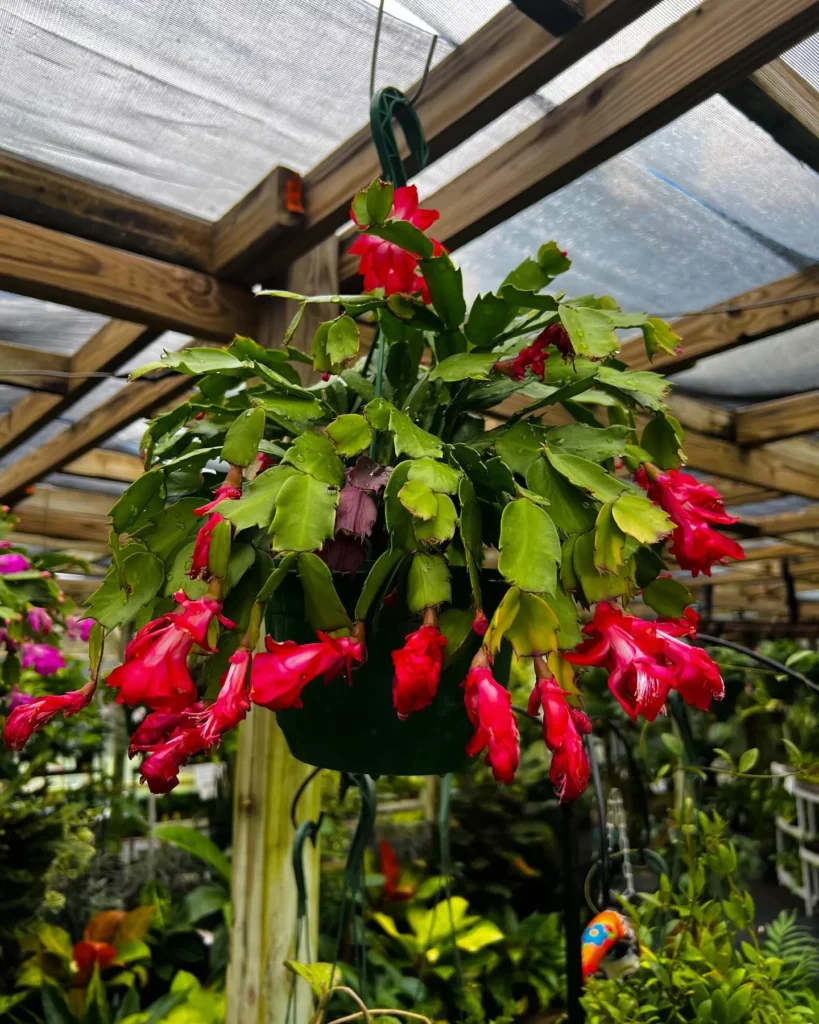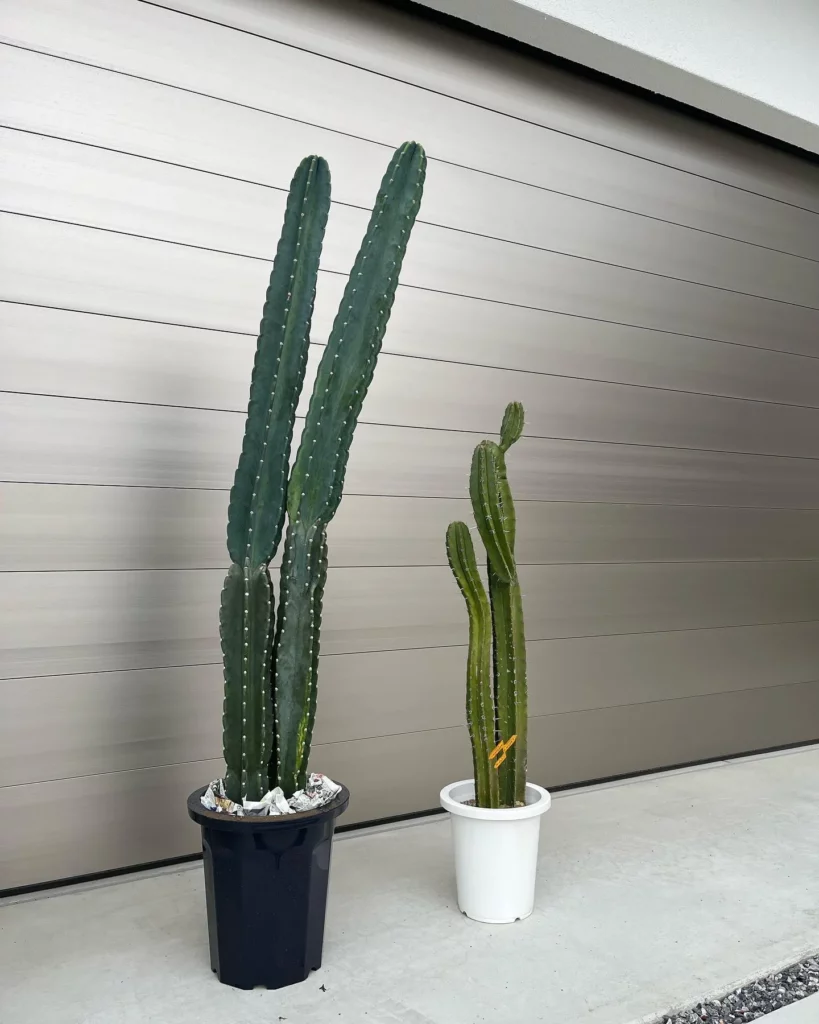🌵 Welcome to the fun and exciting world of cacti! In this article, we’re going to learn about 37 different types of these cool plants. Cacti are super tough – they can live in really dry places where most plants can’t survive. 🌞 We’ll see big cacti that reach high in the desert, and small ones with pretty designs.
🌼 Every cactus is special in its own way. So come along as we check out each one of these 37 cacti. You’ll be surprised at how many different and interesting kinds there are! 🤩
Prickly Pear Cactus



The Prickly Pear Cactus, known for its distinctive paddle-like segments, thrives in arid environments. Its flat, fleshy pads turn a lush green after rain, and it blooms with vibrant flowers in shades of yellow, red, or purple. This cactus is not only a staple in desert landscapes but also in culinary traditions, where its fruit and pads are used in various dishes.
- The fruit of the Prickly Pear is called “tuna” and is edible.
- It can grow up to 6 feet tall.
- This cactus has been used in traditional medicine for its anti-inflammatory properties.
Peyote Cactus



Peyote is a small, spineless cactus with psychoactive alkaloids, particularly mescaline. It’s native to the southwestern United States and Mexico and grows low to the ground, preferring limestone soils. The Peyote cactus is known for its prominent role in Native American religious rituals.
- Peyote can take up to 30 years to reach maturity.
- It has small pink or white flowers.
- Peyote is listed as a Schedule I drug in the United States.
Fishhook Cactus



The Fishhook Cactus is named for its curved, hook-like spines. It typically grows as a solitary, round cactus and is renowned for its large, vivid flowers that bloom in hues of pink, red, or purple. This cactus is often found in desert grasslands and rocky slopes.
- The flowers open at night and close in the morning.
- It produces small, fleshy fruits that are edible.
- This cactus can store water efficiently to survive long dry periods.
Christmas Cactus
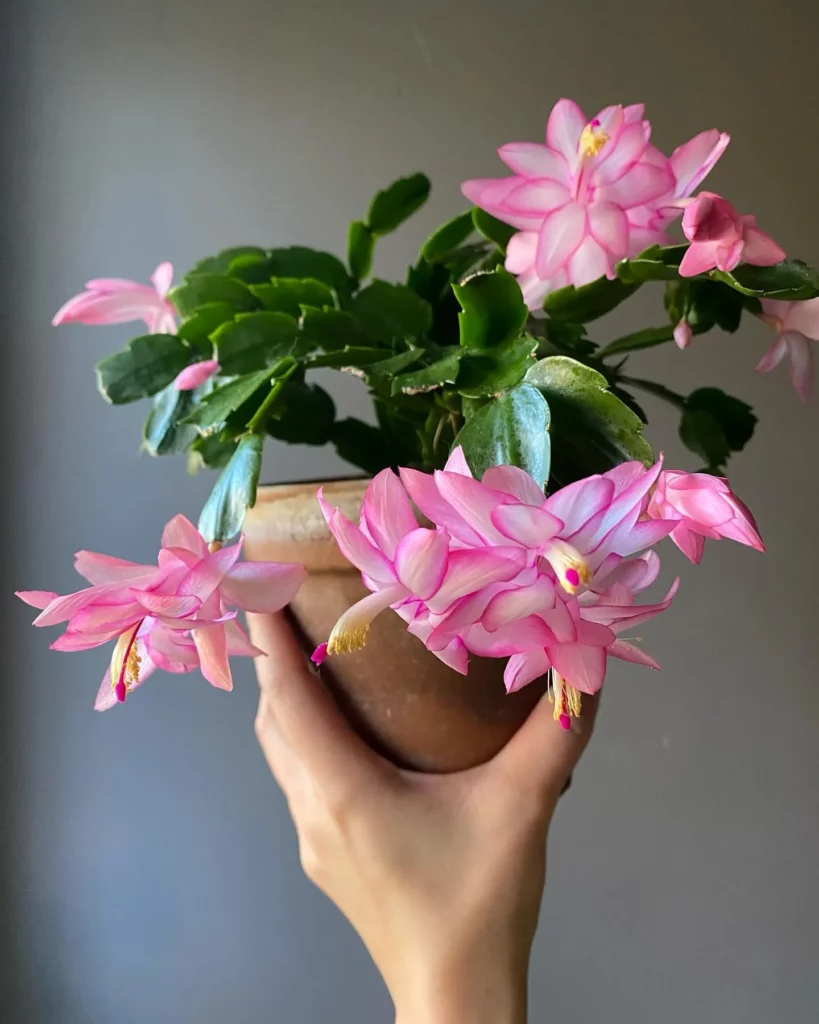

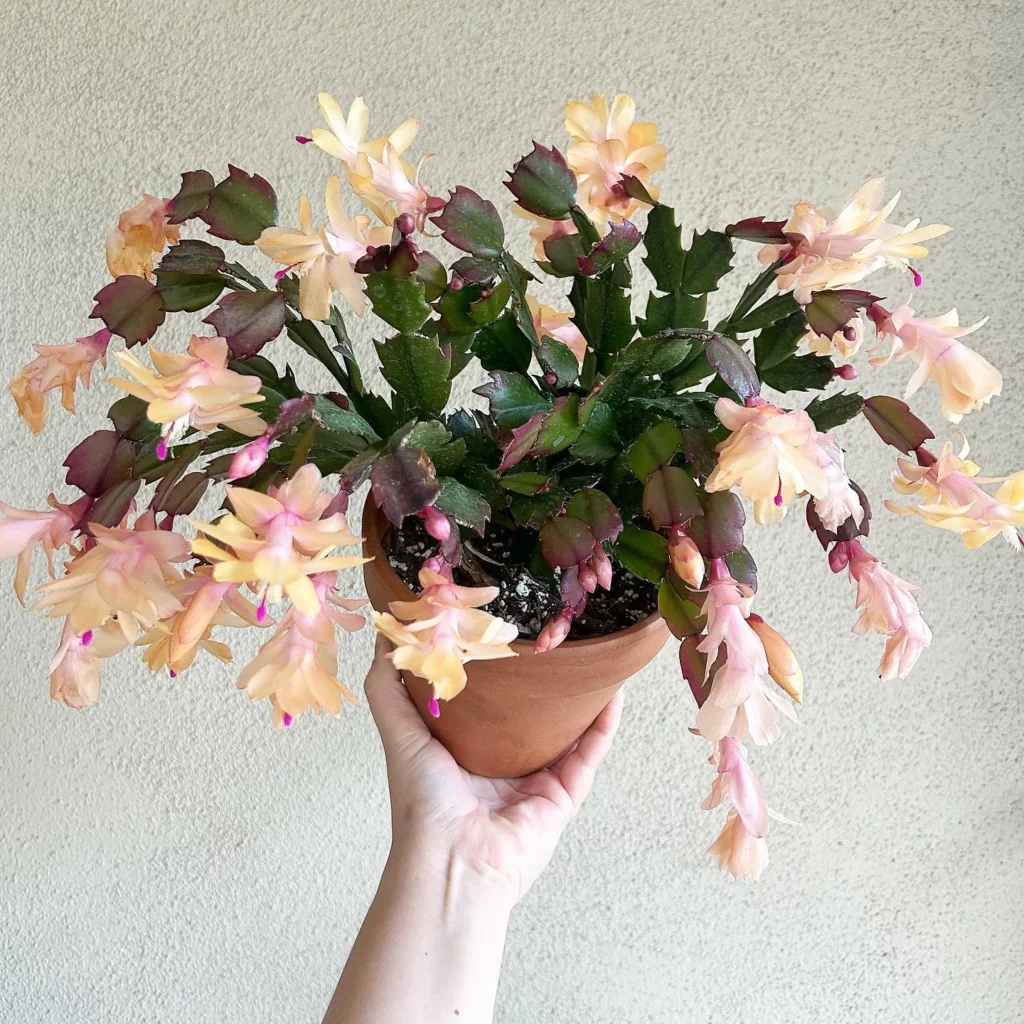
The Christmas Cactus, a popular houseplant, is known for its cascading branches and bright, tubular flowers. It blooms in winter, around Christmas time, hence its name. Unlike typical desert cacti, it prefers a more humid environment and indirect light.
- It’s native to the coastal mountains of southeastern Brazil.
- The Christmas Cactus can live for 20 to 30 years.
- It propagates easily from stem cuttings.
Bunny Ears Cactus



Resembling the shape of rabbit’s ears, the Bunny Ears Cactus has a unique and playful appearance. It grows in pairs of pad-like stems covered with tiny, hair-like spines. This cactus is a popular choice for xeriscapes and indoor decoration due to its low maintenance needs.
- It rarely flowers.
- The cactus can grow up to 3 feet tall.
- Its spines can cause skin irritation upon contact.
Pincushion Cactus



The Pincushion Cactus is a small, spherical plant, making it a perfect fit for small pots and indoor gardens. Its dense covering of spines resembles a pincushion. During spring, it produces small, colorful flowers at the top.
- This cactus comes in various colors, including green, blue, and purple.
- It’s native to the southwestern United States and Mexico.
- The Pincushion Cactus can live for several decades in the right conditions.
Old Man Cactus



Named for its long, white hairs that resemble an old man’s beard, the Old Man Cactus is both striking and whimsical. It grows slowly into a tall, columnar shape and can reach heights of over 10 feet. This cactus is a favorite among collectors for its unique appearance.
- The hair-like spines provide protection from the sun.
- It produces red or yellow flowers.
- The Old Man Cactus can live for many years.
Mistletoe Cactus



The Mistletoe Cactus is a tropical, epiphytic plant, contrasting with the typical desert habitat of most cacti. It has slender, trailing stems and small, berry-like fruits. This cactus prefers shaded, humid environments, often growing on trees in its native rainforest habitat.
- It bears small white or pink flowers.
- The fruits are edible and sweet.
- It’s native to rainforests in Central and South America.
Rat Tail Cactus



The Rat Tail Cactus is known for its long, trailing stems, which can grow up to 3 feet in length. Its bright pink or red flowers contrast sharply with its dark green stems. This cactus is commonly grown in hanging baskets due to its cascading growth habit.
- It’s native to Mexico.
- The flowers bloom in spring and last for several days.
- It’s one of the fastest-growing cacti.
Ladyfinger Cactus



The Ladyfinger Cactus, named for its slender, finger-like stems, is a compact and attractive species. It’s covered with white spines and blooms with bright pink or red flowers. This cactus is perfect for small spaces and indoor cultivation.
- It can grow up to 7 inches tall.
- The flowers appear at the tips of the stems.
- It’s native to northern Mexico.
Lace Cactus



The Lace Cactus is a small, globular cactus known for its intricate network of white spines that give it a delicate, lace-like appearance. It blooms with stunning pink or purple flowers in the summer, creating a striking contrast. This cactus is native to Texas and northeastern Mexico, thriving in rocky soils.
- It can reach a height of up to 6 inches.
- The Lace Cactus is part of the Echinocereus genus.
- It’s considered endangered in its natural habitat.
Blue Candle Cactus



The Blue Candle Cactus, also known as Myrtillocactus geometrizans, stands out with its blue-green stems and tree-like growth pattern. It can reach impressive heights, making it a dramatic addition to any landscape. In spring, it produces small white flowers, followed by edible dark blue berries.
- It can grow up to 15 feet tall.
- The Blue Candle Cactus is often used as a rootstock for grafting other cacti.
- Its berries are known as “garambullos” and are used in Mexican cuisine.
Snowball Cactus



The Snowball Cactus, belonging to the Mammillaria family, is admired for its spherical shape and dense covering of white spines, resembling a snowball. It’s a small cactus, ideal for indoor growing. During spring, it produces a crown of small pink or white flowers.
- It can grow up to 8 inches in diameter.
- The Snowball Cactus is native to Mexico.
- It’s relatively easy to care for, making it popular among beginners.
Feather Cactus



The Feather Cactus, known scientifically as Mammillaria plumosa, is unique for its soft, feather-like spines that form a dense, fluffy covering over the plant. It’s a small, clumping cactus that produces yellow or white flowers. This species is native to northeastern Mexico and is a favorite among collectors.
- The spines are actually modified leaves.
- It rarely grows taller than 5 inches.
- The Feather Cactus requires more humidity than most cacti.
Blue Barrel Cactus



The Blue Barrel Cactus, distinct for its blue-gray color and barrel-like shape, is a striking species. It can grow up to 3 feet in height and produces vibrant yellow flowers in the summer. This cactus is native to the deserts of southwestern United States and Mexico.
- It’s also known as the Blue Ferocactus.
- The Blue Barrel Cactus can live for over 100 years.
- It’s capable of storing large amounts of water to survive droughts.
Saguaro Cactus
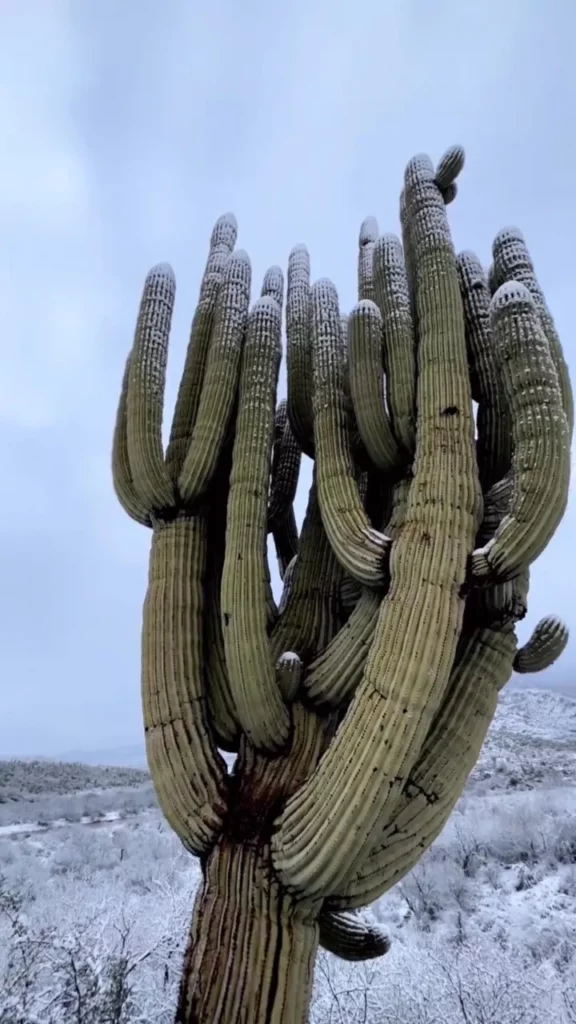
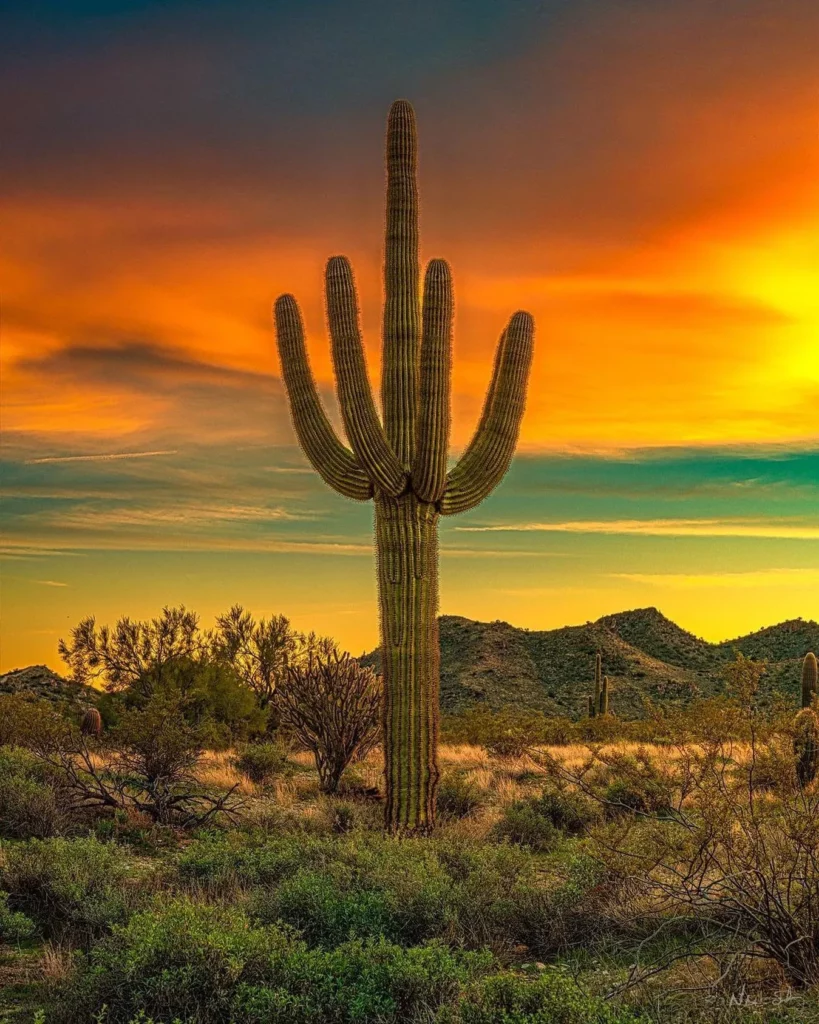
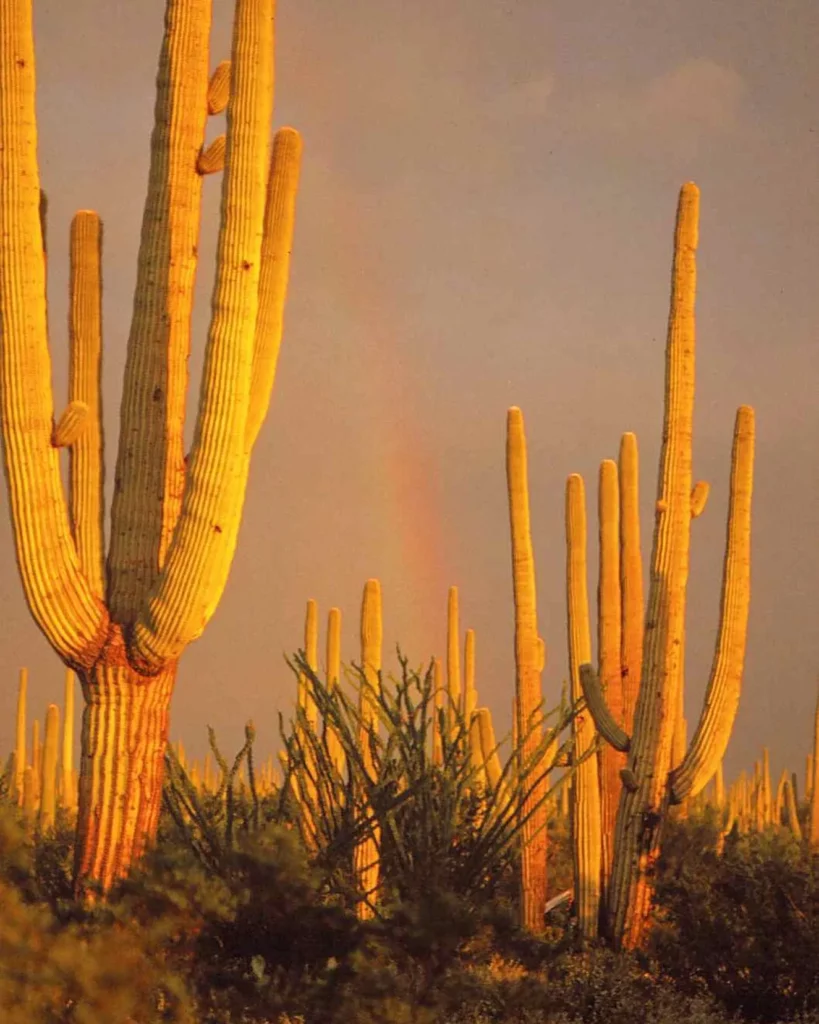
The Saguaro Cactus is an iconic symbol of the American Southwest. It’s known for its massive size, reaching up to 60 feet, and its distinctive arm-like projections. The Saguaro blooms with white flowers and produces red, edible fruits.
- It can live for more than 150 years.
- The Saguaro is native to the Sonoran Desert.
- It’s a vital habitat for desert wildlife, including birds and bats.
Silver Torch Cactus



The Silver Torch Cactus, or Cleistocactus strausii, is a columnar cactus with dense, silvery-white spines. It can grow up to 10 feet tall and produces striking red or burgundy flowers. This cactus is native to high altitudes in Bolivia and Argentina.
- It prefers cooler temperatures than most cacti.
- The flowers are tubular and can be up to 3 inches long.
- The Silver Torch Cactus is commonly grown for ornamental purposes.
Golden Barrel Cactus



The Golden Barrel Cactus is a popular, globe-shaped cactus known for its bright yellow spines. It can grow up to 3 feet in diameter and produces small yellow flowers. Native to Mexico, it’s widely cultivated for its striking appearance.
- It’s also known as Echinocactus grusonii.
- The Golden Barrel is endangered in the wild.
- It’s often used in xeriscaping and drought-tolerant gardens.
Easter Lily Cactus

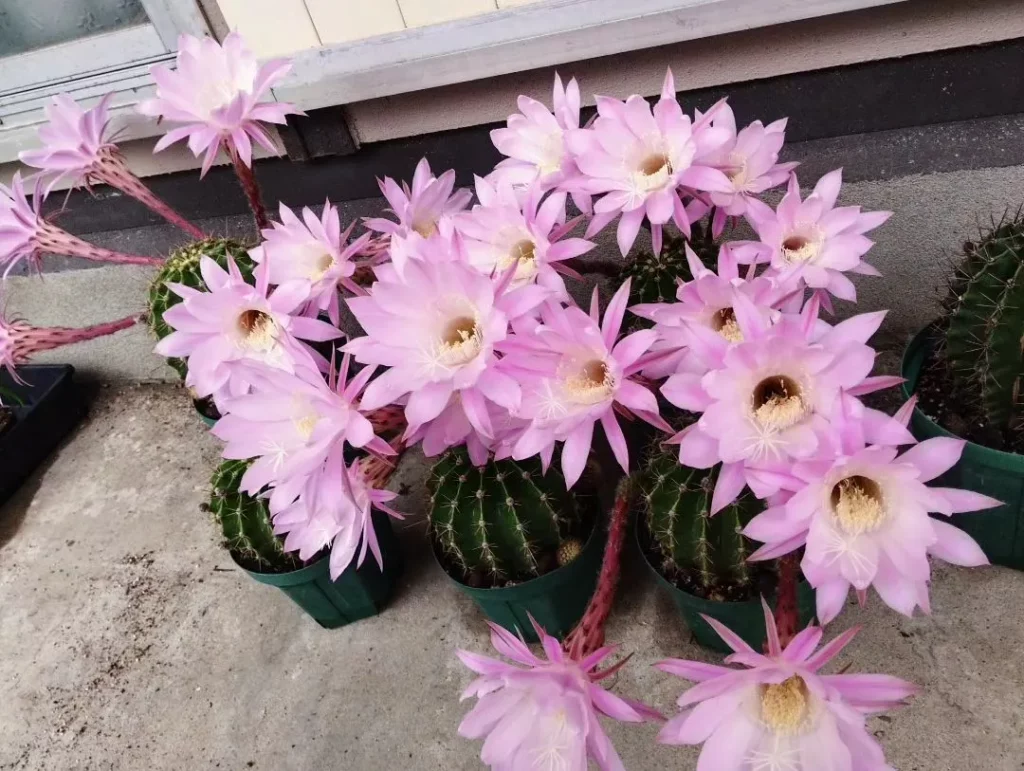
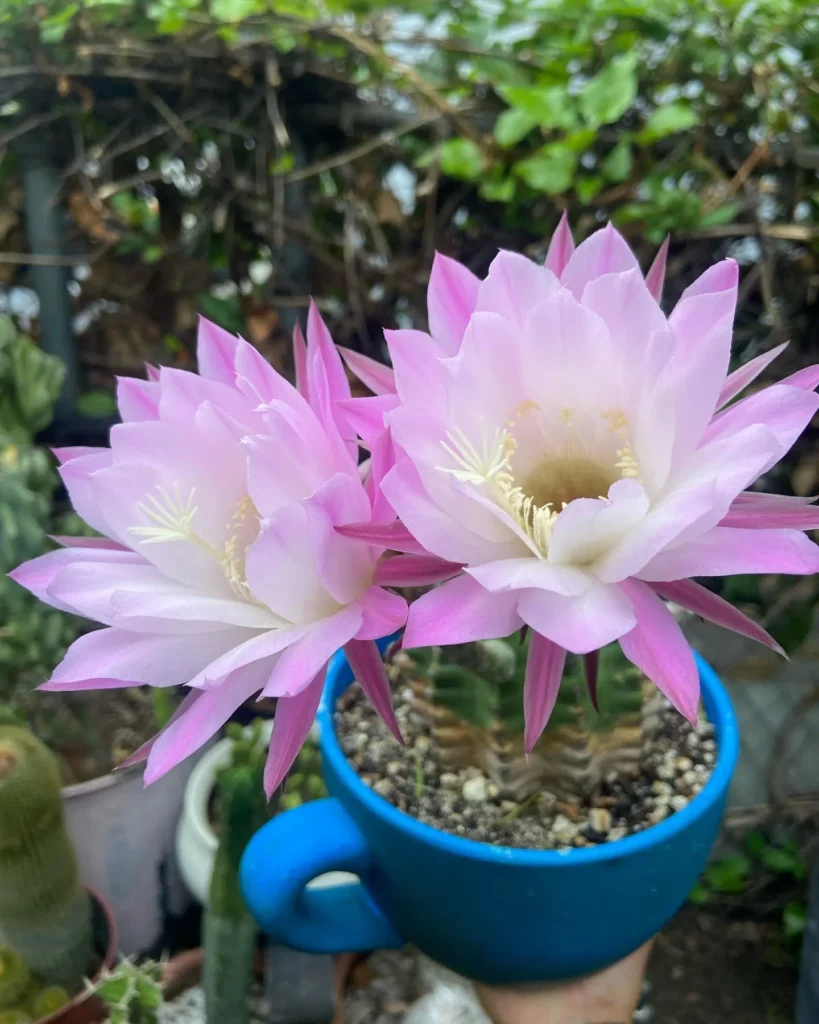
The Easter Lily Cactus, or Echinopsis oxygona, is notable for its large, fragrant, trumpet-shaped flowers that bloom in spring or early summer, around Easter. It has a spherical to columnar shape and is covered with small spines. This cactus is native to South America.
- The flowers can be up to 8 inches long.
- It’s a fast-growing cactus compared to others.
- The Easter Lily Cactus is popular in cultivation due to its impressive blooms.
Candelabra Cactus

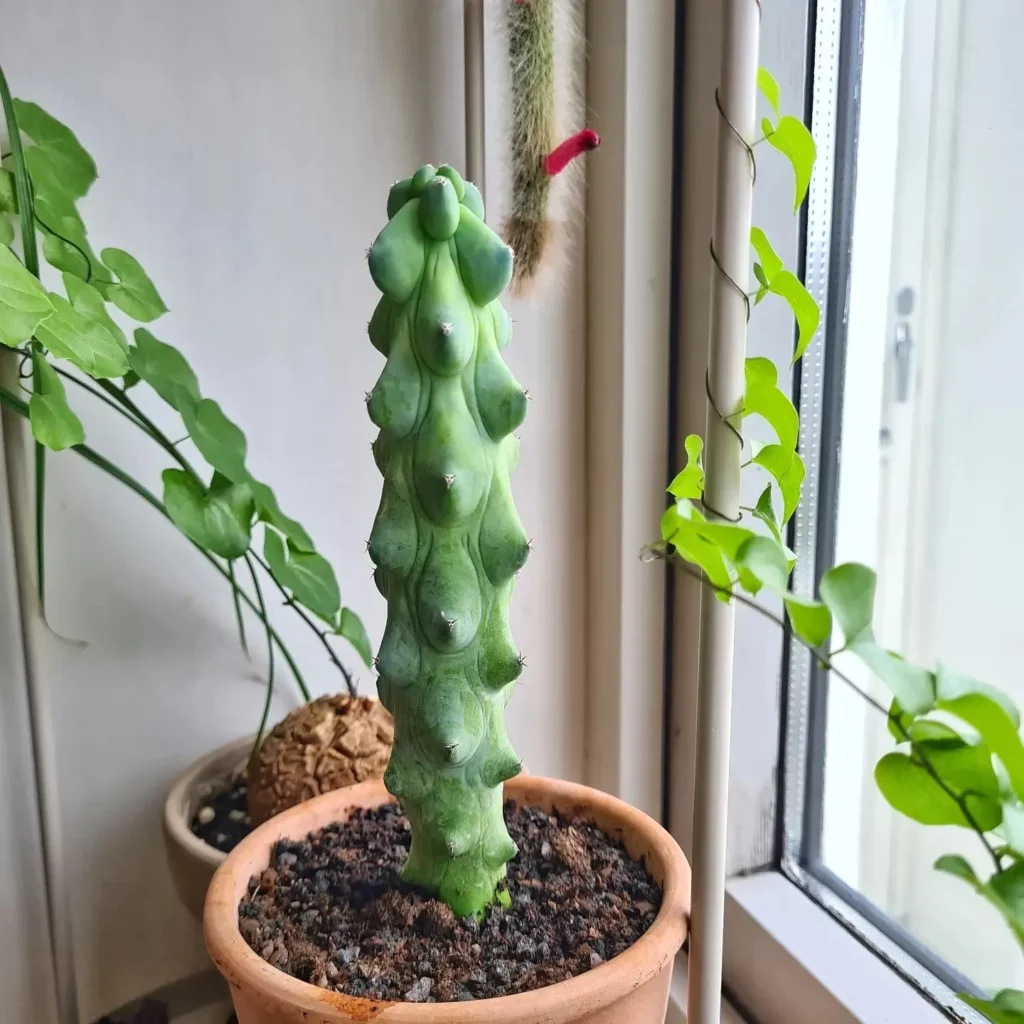
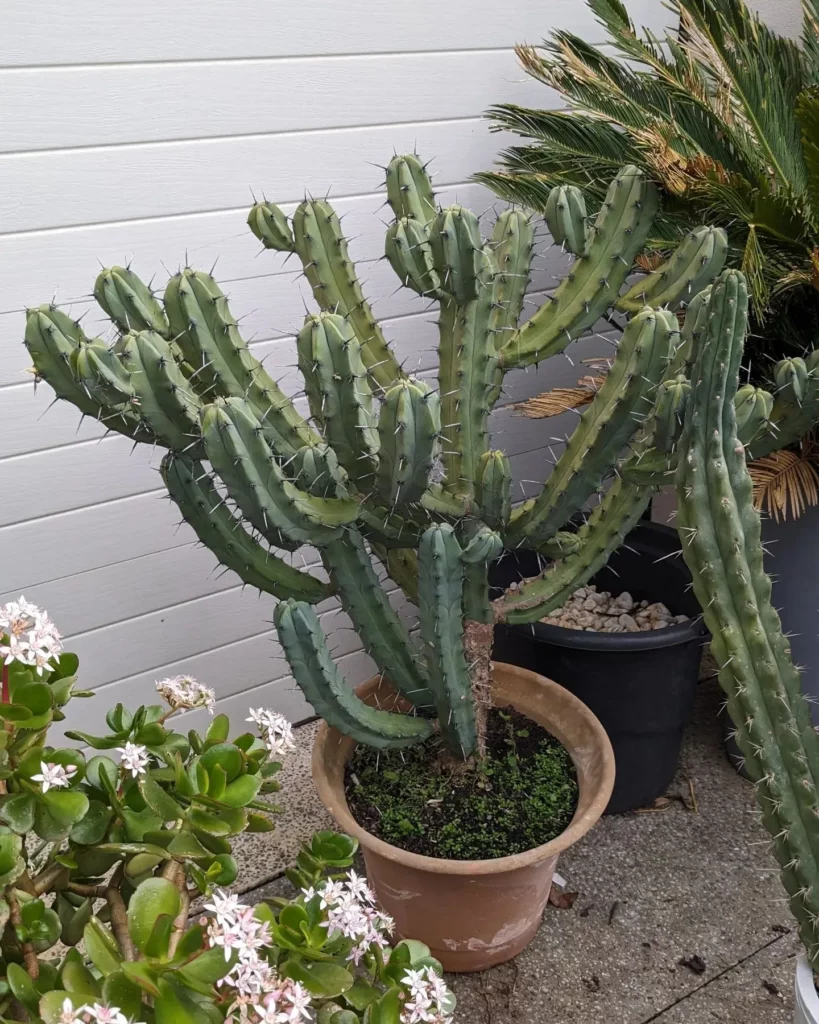
The Candelabra Cactus, known scientifically as Myrtillocactus cochal, is a tree-like cactus that can reach heights of over 15 feet. It has multiple branching arms, resembling a candelabra, and is covered with small, evenly spaced spines. Native to Mexico, it produces small white flowers and edible fruits.
- It’s often used as a living fence in its native range.
- The cactus can be propagated from cuttings.
- Its fruits are known as “garambullos” and are consumed locally.
Beavertail Cactus
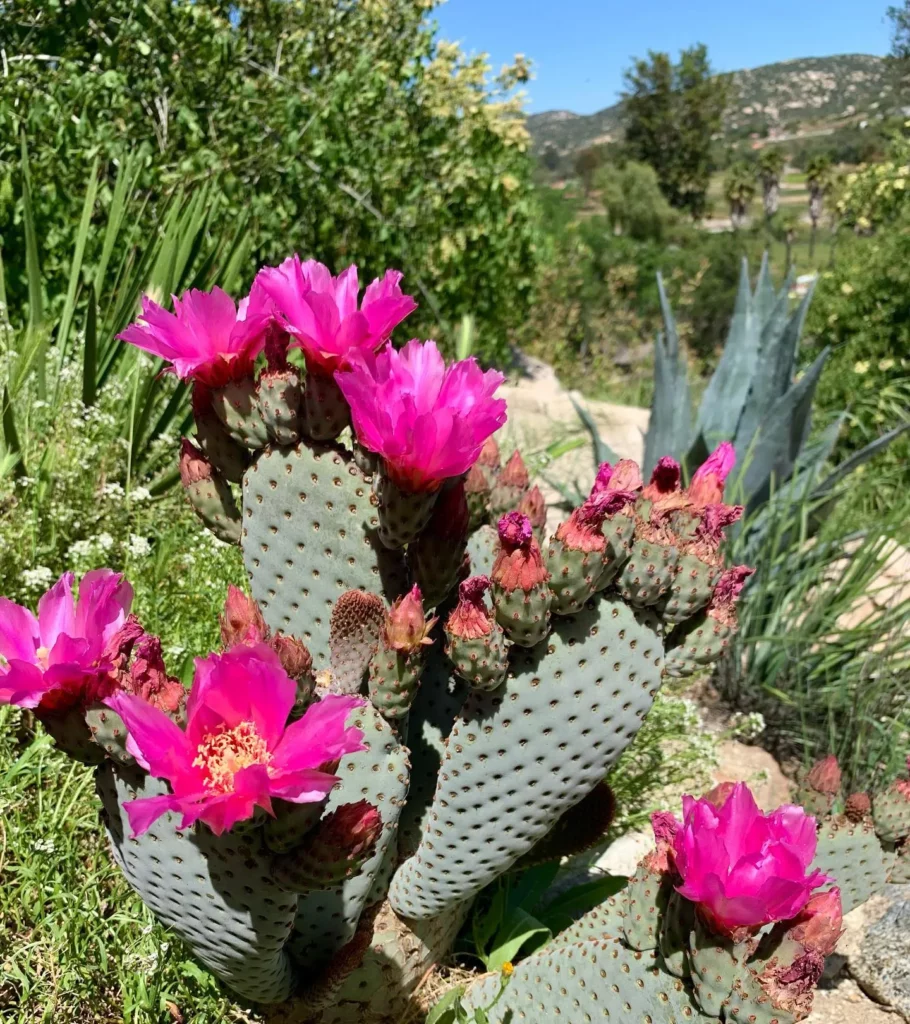
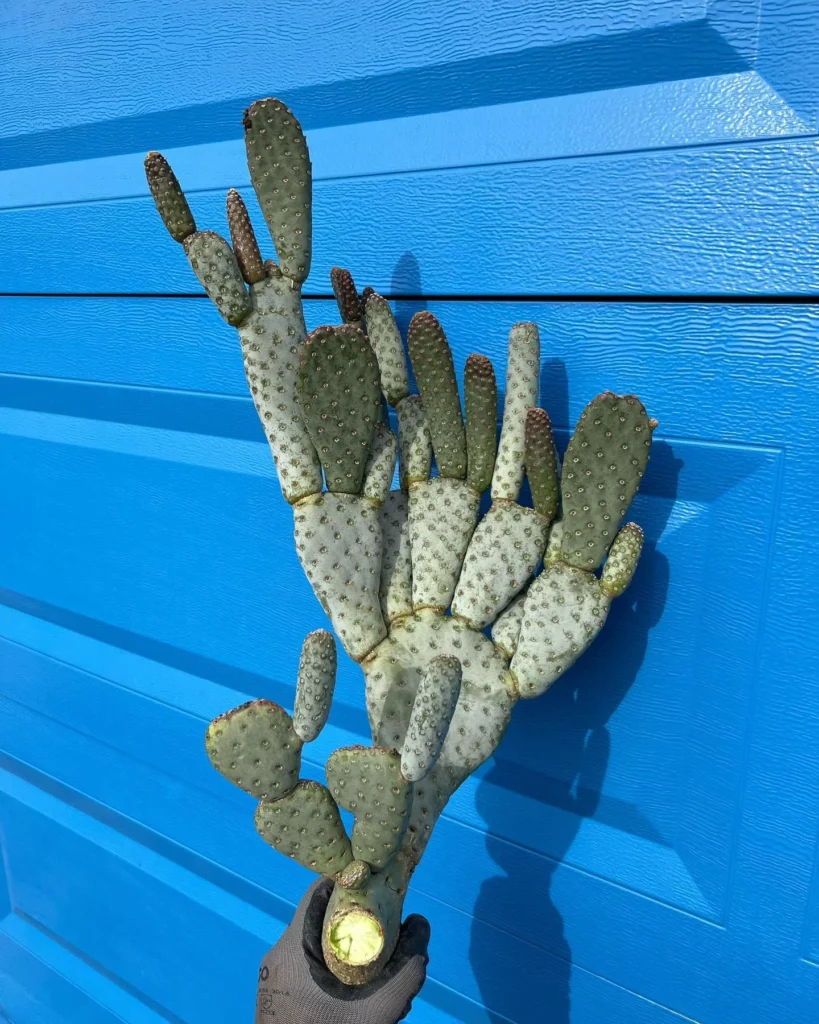
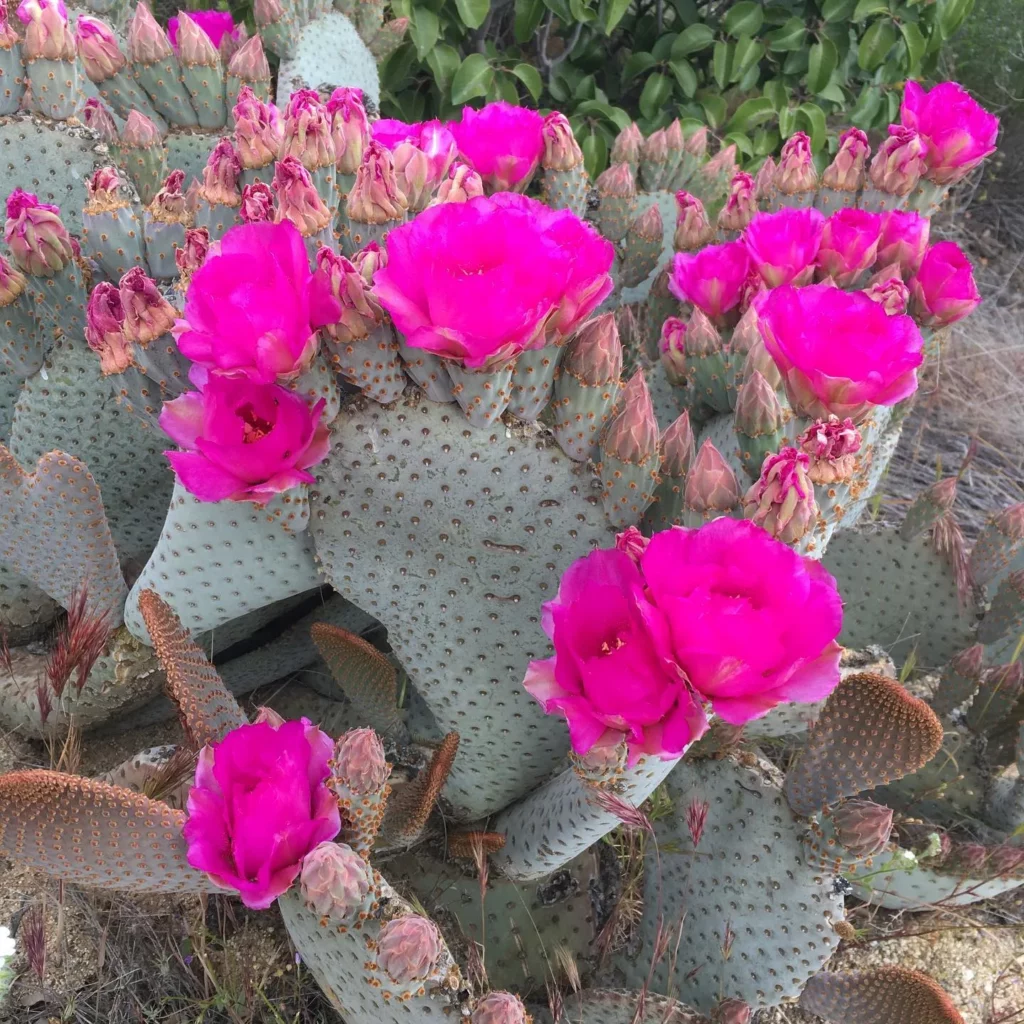
The Beavertail Cactus is named for its flat, paddle-like pads that resemble a beaver’s tail. It’s known for its vibrant pink or purple flowers that bloom in spring. This cactus is a native of the southwestern United States and is often used in desert landscaping for its striking appearance.
- It’s a member of the Opuntia genus, related to the Prickly Pear.
- The Beavertail is drought-tolerant and thrives in full sun.
- It produces small, spiny fruits that are also edible.
Totem Pole Cactus

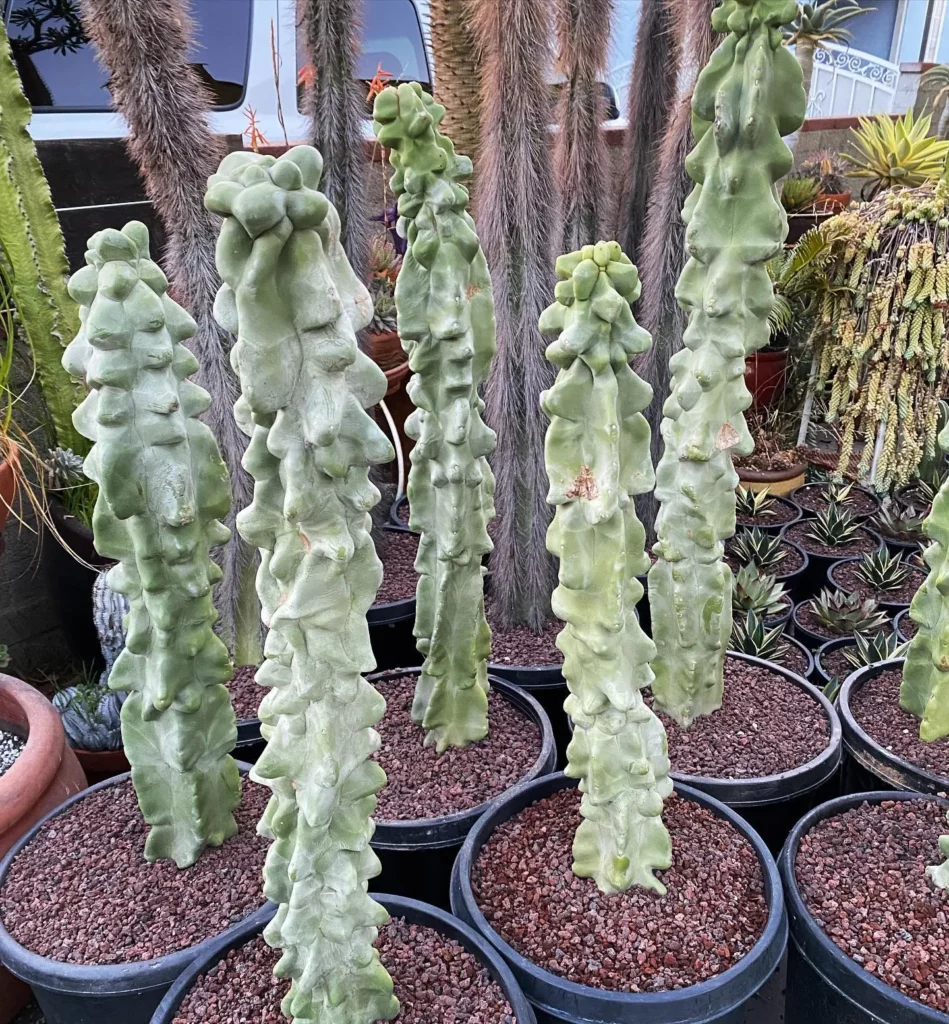
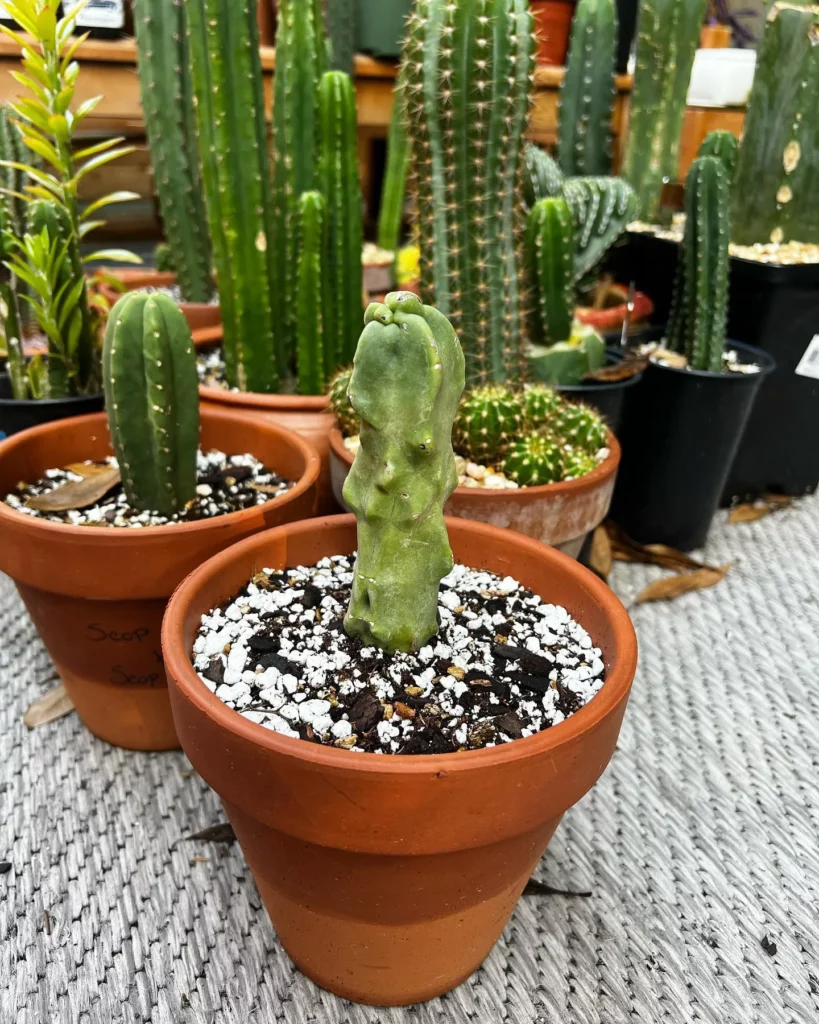
The Totem Pole Cactus, or Lophocereus schottii var. monstrosus, is notable for its smooth, spineless, and knobby surface. It grows slowly into a tall, columnar shape, often reaching over 6 feet in height. This cactus is a favorite for its unusual, sculptural form.
- It’s a naturally occurring mutation of the Mexican Giant Cardon.
- The Totem Pole Cactus rarely blooms or produces seeds.
- It’s popular in cultivation due to its unique appearance and low maintenance.
Senita Cactus
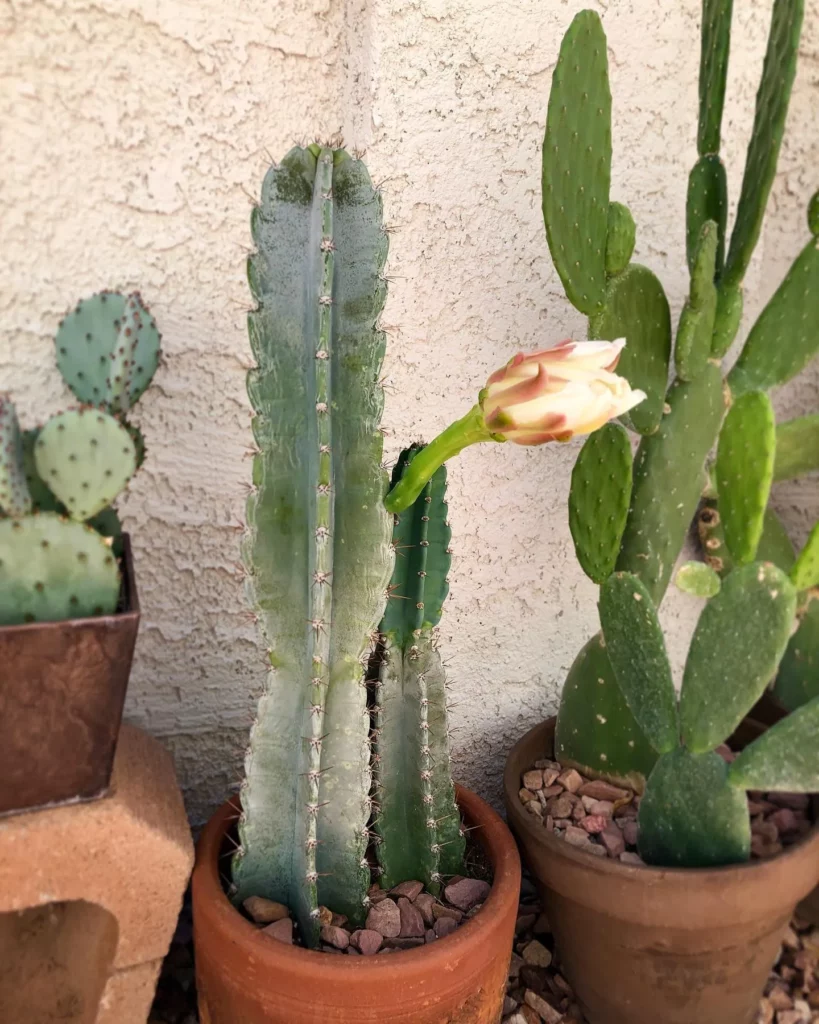

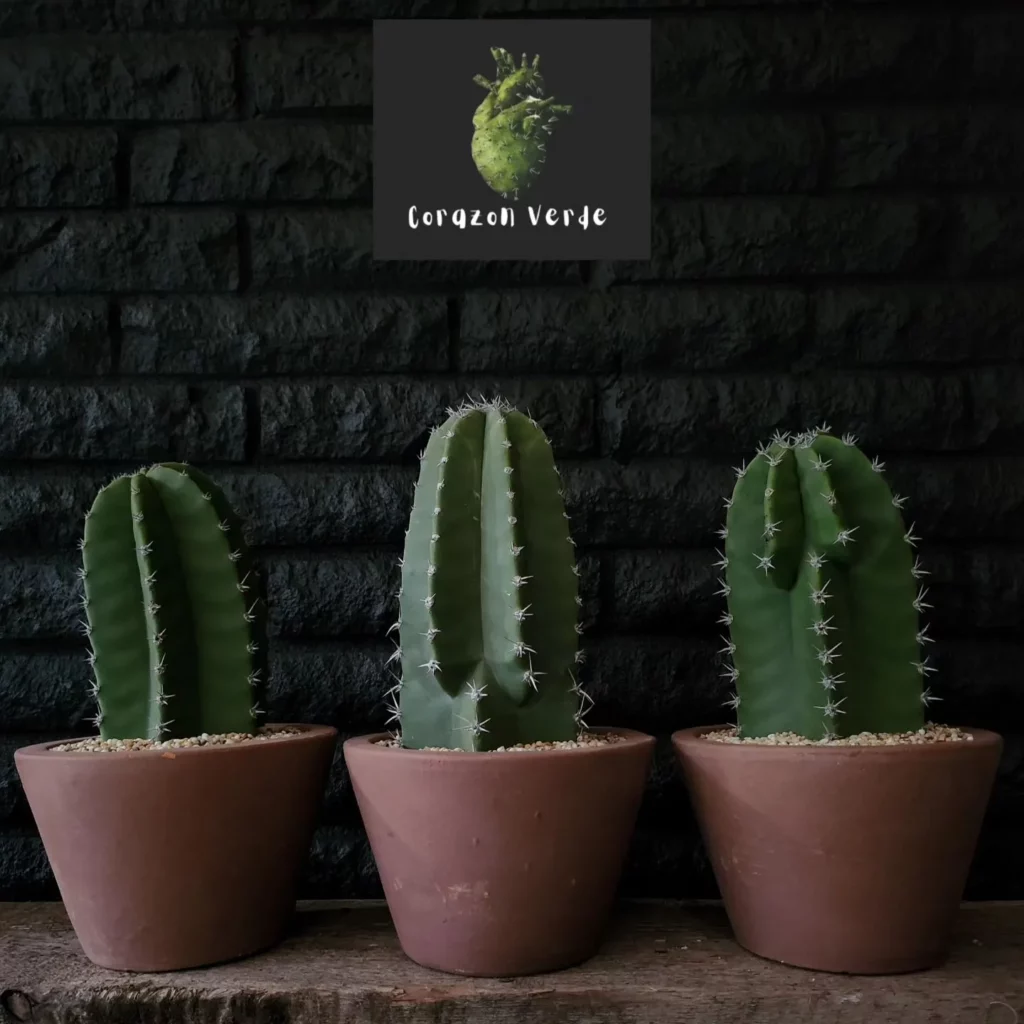
The Senita Cactus is a tall, columnar cactus that can grow up to 15 feet tall. It’s known for its dense covering of gray spines and large, white flowers that bloom at night. This cactus is native to the Sonoran Desert and is an important food source for local wildlife.
- The flowers are pollinated primarily by a specific type of moth.
- It produces small, red, edible fruits.
- The Senita Cactus plays a crucial role in the desert ecosystem.
Organ Pipe Cactus



The Organ Pipe Cactus, named for its multi-stemmed growth resembling organ pipes, is native to the Sonoran Desert. It can grow up to 25 feet tall and produces white, night-blooming flowers followed by edible red fruits. This cactus is a UNESCO World Heritage Site in Mexico.
- It’s scientifically known as Stenocereus thurberi.
- The Organ Pipe is more cold-sensitive than most desert cacti.
- It’s crucial for the survival of several species of bats that feed on its nectar and fruits.
Red Torch Cactus



The Red Torch Cactus, also known as Echinopsis huascha, is admired for its brilliant red, trumpet-shaped flowers. It’s a columnar cactus, growing up to 10 feet tall, and is native to the deserts of Argentina. This cactus blooms in late spring to early summer.
- The flowers can last for several days.
- It’s also known for its decorative, spiny stems.
- The Red Torch Cactus is popular in cultivation for its striking blooms.
Cholla Cactus



The Cholla Cactus, found in the deserts of North America, is known for its segmented branches and sharp spines that easily detach. It blooms with vibrant flowers in shades of red, pink, orange, or purple. This cactus is both admired and feared for its beautiful but hazardous spines.
- It’s also called the “jumping cactus” because the spines seem to jump onto passersby.
- The Cholla provides important habitat for desert wildlife.
- It can regenerate from broken-off segments.
Living Rock Cactus
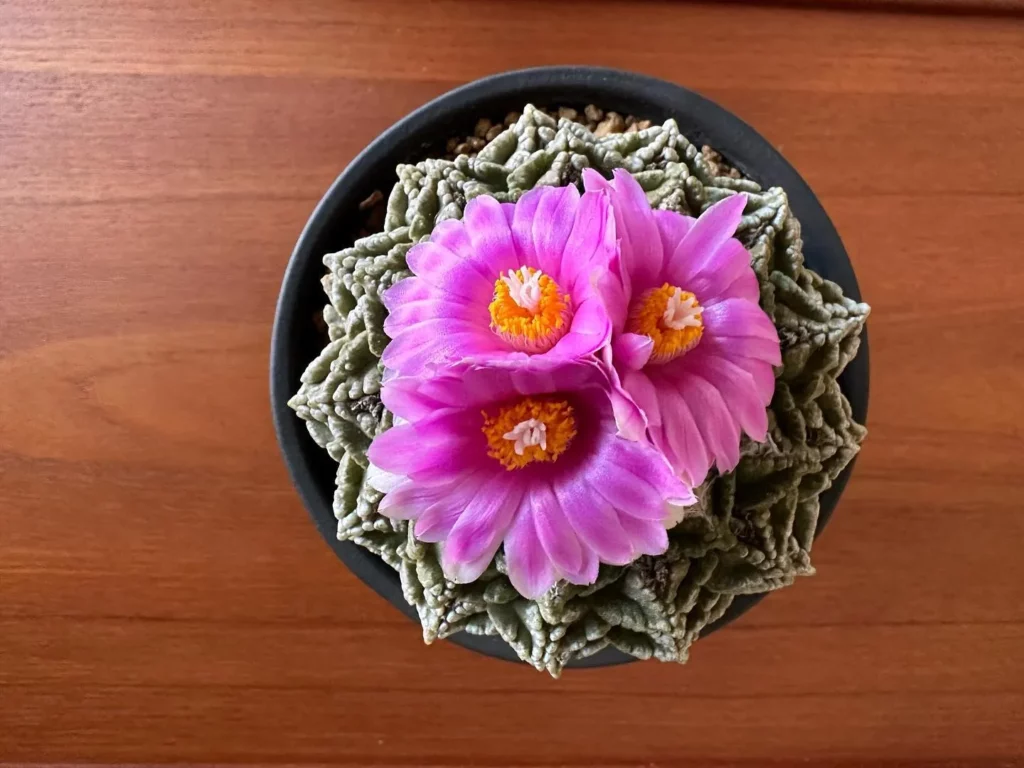
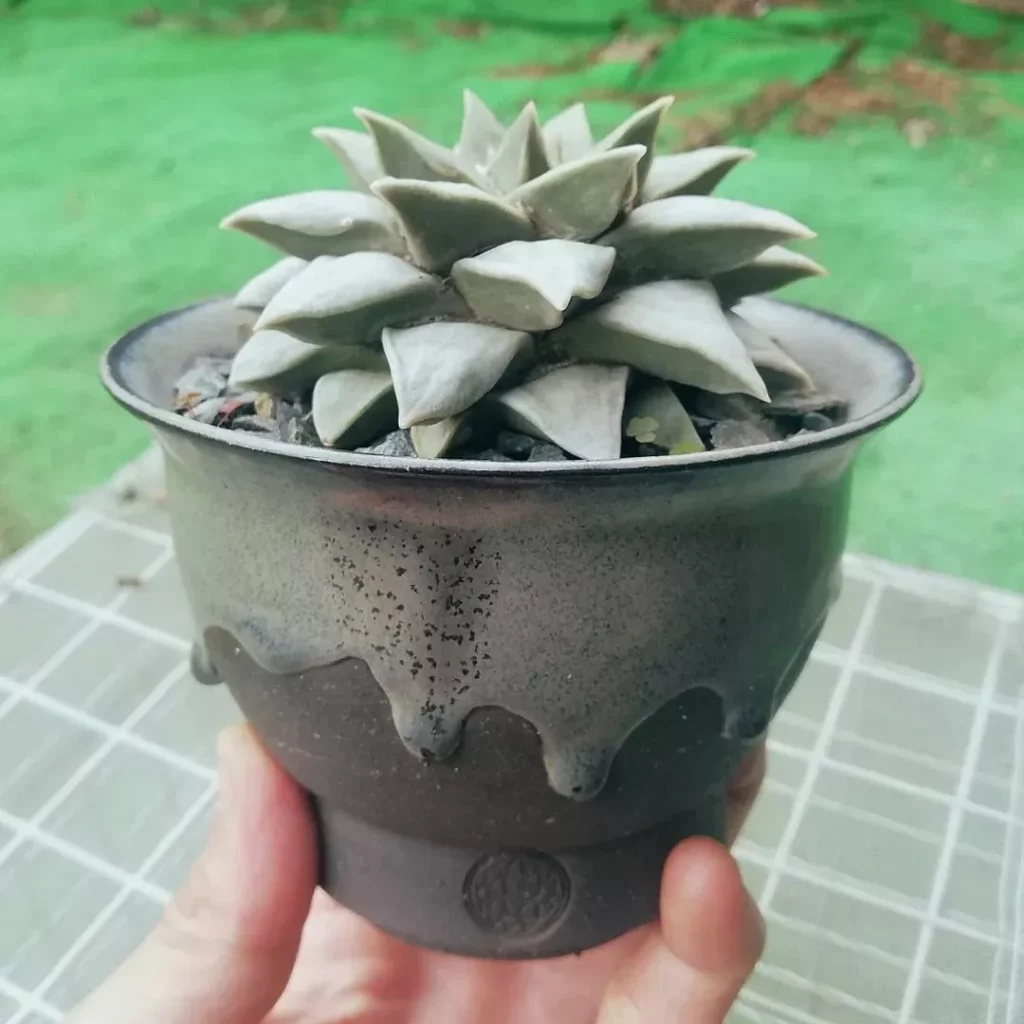
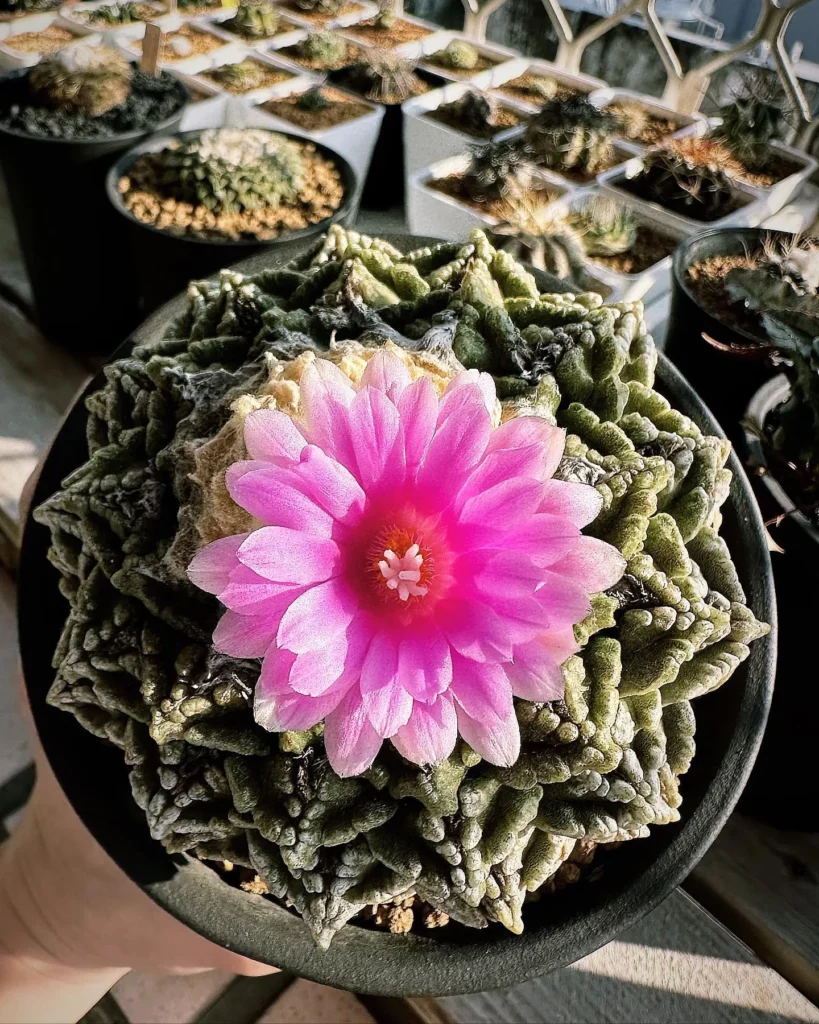
The Living Rock Cactus, a part of the Ariocarpus genus, is a unique cactus that resembles a rock. It’s native to Texas and Mexico and is known for its slow growth and rarity. This cactus produces beautiful pink or white flowers.
- It’s highly sought after by collectors.
- The Living Rock is camouflaged well in its natural habitat.
- Overcollection and habitat loss have made it rare in the wild.
Star Cactus
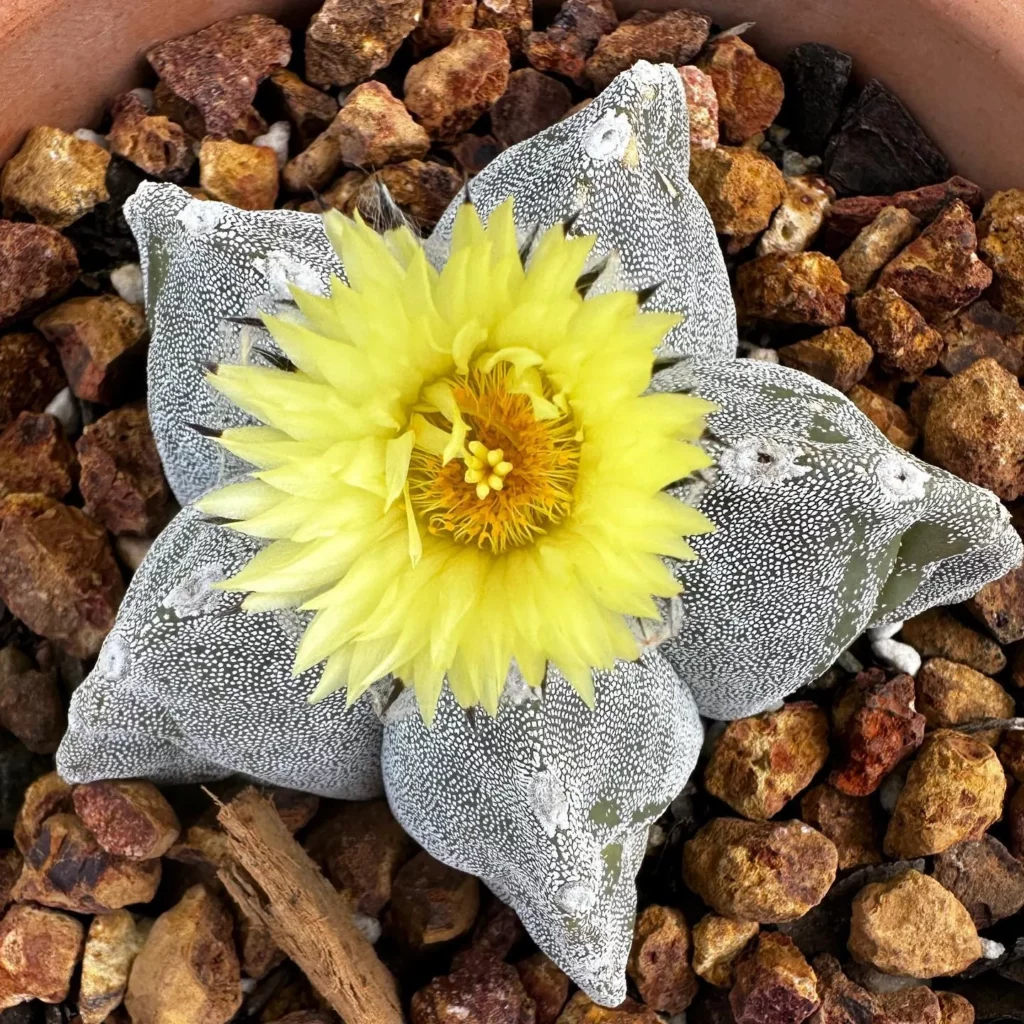
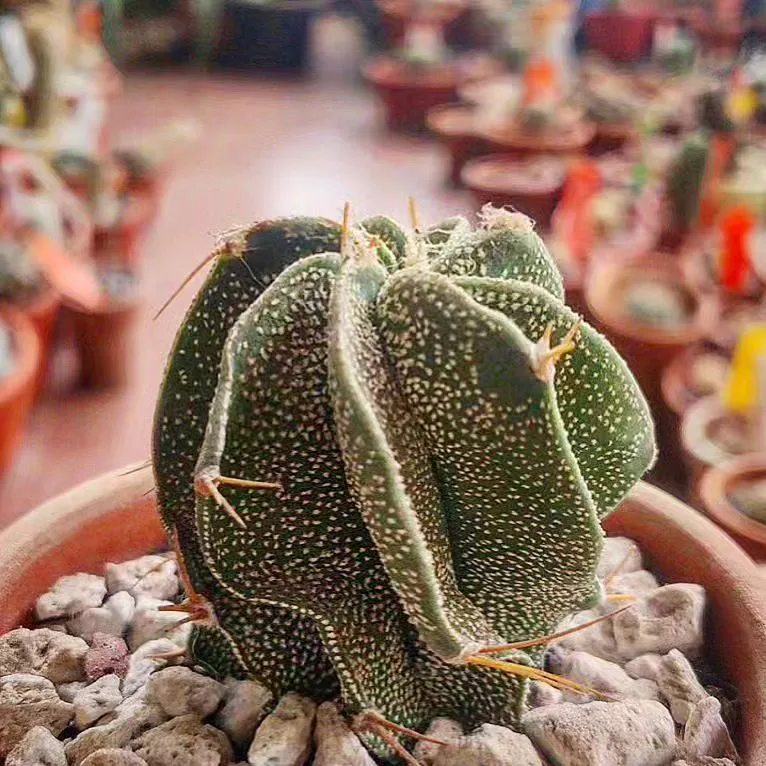
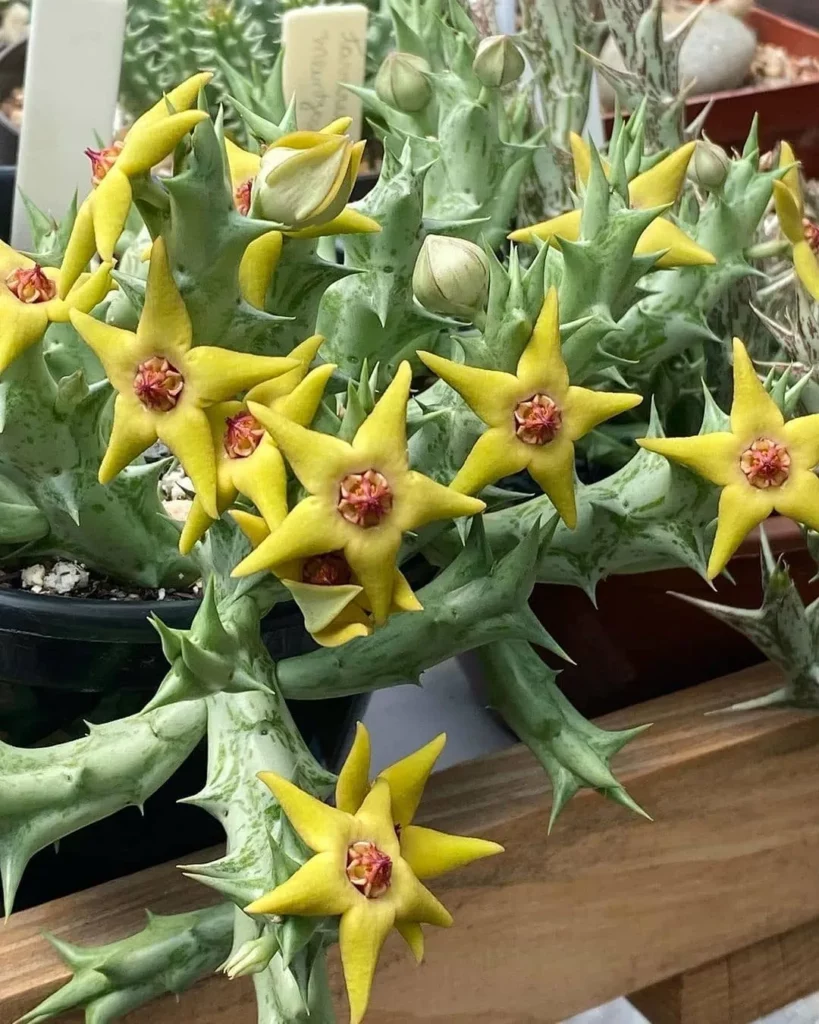
The Star Cactus, also known as Astrophytum asterias, is a small, dome-shaped cactus that resembles a star from above. It’s native to small areas of Texas and Mexico and is known for its striking yellow flowers. This cactus is endangered due to habitat loss and overcollection.
- It’s also called the “Sand Dollar Cactus.”
- The Star Cactus can live for up to 30 years.
- It’s a part of the Astrophytum genus, known for star-shaped cacti.
Claret Cup Cactus
The Claret Cup Cactus, or Echinocereus triglochidiatus, is known for its bright red, cup-shaped flowers. It’s a clumping cactus that can spread out over time, creating a stunning display in spring when it blooms. This cactus is native to the southwestern United States.
- It’s also known as the “Hedgehog Cactus.”
- The Claret Cup is pollinated by hummingbirds.
- It’s often used in rock gardens and desert landscaping.
Grizzly Bear Cactus
The Grizzly Bear Cactus, scientifically known as Opuntia polyacantha, is named for its dense covering of long, white spines that resemble a grizzly bear’s fur. It produces vibrant pink or yellow flowers in the spring. This cactus is native to the western United States and Canada.
- It’s a type of Prickly Pear Cactus.
- The Grizzly Bear Cactus can tolerate extreme cold and heat.
- Its pads are edible and used in traditional dishes.
Rainbow Cactus
The Rainbow Cactus, or Echinocereus pectinatus, is admired for its colorful bands of spines that create a rainbow effect. It’s a small, globular cactus that produces large, vibrant pink or purple flowers. This cactus is native to the deserts of the southwestern United States and Mexico.
- It’s also known as the “Arizona Rainbow Cactus.”
- The Rainbow Cactus blooms in the late spring to early summer.
- It’s popular in cultivation for its striking appearance.
Moon Cactus
The Moon Cactus, a popular houseplant, is actually a graft of two different cacti: the colorful Gymnocalycium mihanovichii on top and a green cactus base for photosynthesis. It’s known for its bright, vibrant colors and easy care. This cactus is a favorite for indoor gardens.
- The colorful top part lacks chlorophyll.
- It’s also called the “Hibotan Cactus.”
- The Moon Cactus has a relatively short lifespan compared to other cacti.
Argentine Giant Cactus
The Argentine Giant Cactus, or Trichocereus terscheckii, is known for its large, white, night-blooming flowers, among the largest of any cactus species. It can grow up to 30 feet tall and is native to the mountains of Argentina. This cactus has a columnar shape and green, ribbed stems.
- The flowers can be up to 12 inches in diameter.
- It’s also used in traditional South American medicine.
- The Argentine Giant is popular in cultivation for its impressive size and flowers.
Turk’s Cap Cactus
The Turk’s Cap Cactus, known scientifically as Melocactus, is notable for its “cap” or cephalium, a structure at the top where flowers and fruits emerge. It’s native to the Caribbean, northern South America, and Mexico. This cactus produces small, pink or red flowers.
- The cap is made of densely packed bristles and wool.
- It’s also called the “Melon Cactus.”
- The fruits are small and berry-like, often eaten by birds.
Ferocactus latispinus
Ferocactus latispinus, also known as the Devil’s Tongue Barrel or Fishhook Cactus, is recognized by its flattened, red or purple spines that resemble fishhooks. It’s a globular cactus that produces bright purple or yellow flowers. Native to Mexico, it’s a popular choice for cactus gardens.
- It can grow up to a foot in diameter.
- The cactus prefers full sun and well-draining soil.
- It’s known for its drought tolerance and easy care.
Ferocactus cylindraceus
Ferocactus cylindraceus, commonly known as the California Barrel Cactus or Compass Cactus, is a striking species native to the southwestern United States and northwestern Mexico. This cactus is characterized by its cylindrical shape, growing up to 3 meters in height, and is adorned with thick, prominent ribs lined with large, hefty spines. It is particularly notable for its vibrant yellow to red flowers, which bloom at the top of the plant during the late spring and early summer, adding a splash of color to arid landscapes.
- The Ferocactus cylindraceus can live for several decades, showcasing its resilience in harsh desert environments.
- It is called ‘Compass Cactus’ because some larger plants lean towards the south, a unique adaptation to the intense desert sun.
- The plant’s fruit is dry and spiny, often consumed by local wildlife and used in traditional Native American crafts.
Arizona Barrel Cactus
The Arizona Barrel Cactus, scientifically known as Ferocactus wislizeni, is a robust and distinctive cactus native to the deserts of the southwestern United States. It is renowned for its barrel-like shape, growing up to 2 meters in height and about 75 cm in diameter, with ribs covered in hefty spines. The Arizona Barrel Cactus blooms in the late summer, producing circular, bright orange or red flowers that contrast beautifully against the green of the desert.
- This cactus species is often mistaken for the Fishhook Barrel Cactus but can be distinguished by its straighter spines.
- It plays a crucial role in desert ecosystems, providing shelter and moisture for various animals.
- Interestingly, the Arizona Barrel Cactus is known to tilt as it ages, often referred to as the ‘compass of the desert’ due to this leaning habit.


